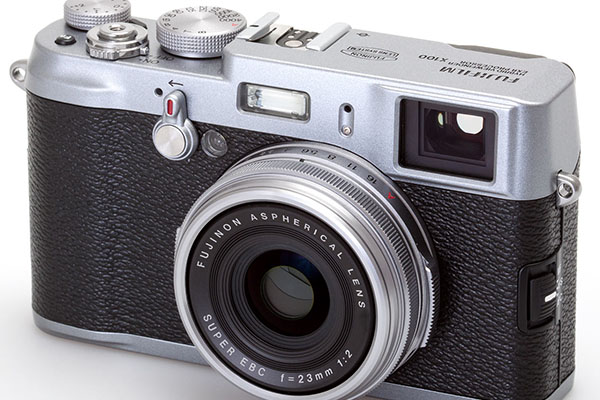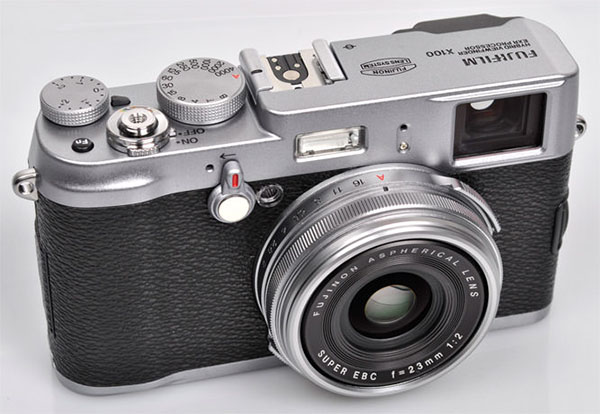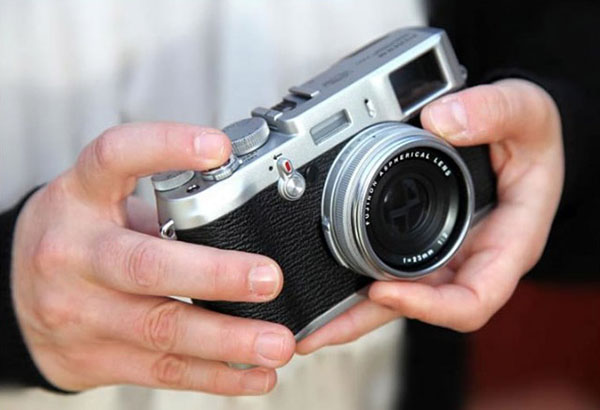Fuji FinePix X100 has received remarkably numerous accolades for the design and the usability. Though tagged as a professional camera, it consists of features that can be used by even beginners. Hence it can be stated as the wider usability range of cameras.
The FinePix X100 is one of its kinds of DSLR camera with compact design. It is sure to evoke a nostalgic feeling for those who had used DSLR cameras from previous decades. It is because the artistic essence of retro camera is integrated in to the external design concept of this camera. The highlight feature of the product is that the versatility and usability are delivered at style.
Not to mention, the camera is poised with several achievements such as the Camera Grand Prix & Japan Editors Choice Award, Digital Camera Enthusiast and TIPA awards. Whatever is the award or recognition category, the final verdict given by various forums projects an all-round robustness of the FinePix X100.
Overview

The APS-C sensor serves as the backbone to generate quality images at higher ISO sensitivity. Almost 12.3 million pixels are closely packed and the technology speaks for the final output. Another characteristic highlight is the lens optimisation. Maximum light is captured by the lens and then expanded and delivered all the way to the sensor.
The EXR processing engine takes the camera for a multi-purpose ride, blending the best of the resolution and low noise reduction. The image quality is perfected by the tone and sharpness adjustment. Aspects like the auto bracketing of the dynamic range, ISO, film simulation and AE makes it an excellent camera even in the hands of beginners.
Design
The Fujifilm FinePix X100 Digital Camera is designed as how a traditional camera looks. It is compact and light-weighted and can be carried around swiftly. The body is built using magnesium alloy of high precision so as to provide reinforced durability. The rest of the body has leather like finish that gives a good grip and feel. The major difference from the contemporary ones is the style and the layout of the buttons.
The power switch is a slider type and is fused at the bottom of the shutter button. Though it does not cause any major confusion while taking the pictures, the power switch is a small type of rotating knob, hence cannot be handled at ease if worn with gloves. The LCD monitor in FinePix X100 measures 2.8 inch with 460k dots and gives 100% coverage. The compensation dial and the exposure dial are designed with mechanical mastery. These dials aid each other by an individual base.
These two incorporate two different types of plastic washers. In addition to this, spring with a matching strength offers the click notification under different angle of rotation. The construction offers the click sensation as preferred by the user. Not to mention, the torque and the balanced smoothness is an added bonus.
The aperture ring consists of eight grooves that have been precisely cut in the inner area. The aperture setting can be activated thereby allowing the range from to F2 to F16. The rotation interval of aperture is reduced from 12° to 10.5° satisfying the needs of professional photographers.
The front part is primarily occupied by the lens set-up. The focus ring can be turned in either the left or right to adjust the distance between the camera and the subject in the manual shooting mode. The lens used is the Fujinon fixed focal length and sits firmly inside the camera. The AF illuminator blinks to assist the auto focus mode. At the same time, it also blinks when the self timer mode is activated. A small hot-shoe duct is available to mount the external flash.
The camera operates with third party flash, provided they meet the exposure metering, aperture and sensitivity requirements. Such a foreign flash set-up can be controlled through the in –built flash operation. The camera is equipped with the optical/ electronic view finder and the LCD screen for viewing. Either one of the option can be chosen by pressing the view mode.
However eye sensor, located adjacent to the view finder window comes handy in the automatic display selection. It activates the view finder when the user puts the eye on it and it activates the LCD monitor when the user moves the eye away from it.
The eye sensor sensitivity is high and responds to object brighter such as the direct light. The microphone is fixed next to the view finder selector. However the microphone is susceptible to the sound made from the lens during recording.
Shutter Dial
The shutter button, exposure compensation dial and the shutter speed dial are closely located and resembles like three knobs in varying sizes. The exposure compensation dial can be tuned to control the light entering the lens. The exposure range is within +2EV to – 2EV and is incremented in the value of 1/3 EV.
The shutter speed dial can be set in the program mode, shutter priority mode, aperture priority and the manual exposure mode. In any of the setting, the shutter priority dial has to be rotated to the correct alphabet. It is possible to get the long time exposure by either setting the shutter speed or bulb B. It can even support third party remote release to be used for long time exposures.
View Finder
As stated earlier the camera has hybrid view finder, viz electronic and optical view finder. Merging such a variety of viewfinders has its own purpose. The optical view finder in Fujifilm FinePix X100 12.3 MP Camera can be selected when the subject’s expression has to be checked all the time.
Moreover, the field of depth is larger than the lens thus enabling the user to spot the subject without even the need for removing the eye from the view finder. However, in certain cases parallax is inevitable. On the other hand, in case of the electronic view finder pictures everything as seen in the lens such as the depth of field. It can deliver precise shots, yet with a little display lag, which can be avoided in the optical view finder setting.
Camera Rear Side
The Fujifilm FinePix X100 camera rear side is neat and is different from the other camera with respect to having a few buttons on the either side of the LCD screen. The left side hoists the diopter adjustment button, play back button, auto exposure button and view mode button. The diopter can be adjusted to -2- +1 to get the difference in vision and to capture a sharp focus.
The command dial has a four directional navigation button and located on the right side of the camera. The four operations that can be performed include delete, flash, macro and white balance. At the same time the command dial can be rotated to fix the combination of aperture and shutter speed. Though both the operations are integrated in the command dial, any accidental touch of the controls while shooting can be avoided by locking it.
All in all, Fuji FinePix X100 has a different operating mechanism than the regular ones. It is because some of the features can be controlled with more than one button. Take for an example, the command dial adjust the aperture speed and the shutter speed and is located adjacent to the LCD monitor.
However, it can be controlled using the command control slider switch by either turning it to the left or the right and is located away. The same is the case with the zoom function, which can be fine-tuned by pressing the centre of the command dial. Therefore the construction is made versatile and it is up to the user to make use of such inter-linked connections.
Features
CMOS Sensor
The censor used is the APS-C CMOS sensor which is claimed to achieve the performance level ten times better than the existing FinePix compact variety. For a compact variety, this is amazingly good, and the performance is made better by dissipating the heat in a sophisticated manner. In addition to this, the set-up of the microlens is well optimised and the incident light captured is expanded covering the edge of the sensor. Due to this, the light can be even distributed to the photodiodes to get a crisper image.
EXR Processor
The EXR processor is projected as the next generation engine configured with dual CPU and EXR core. The function of the processor engine is multifold enhancing the performance in three levels, viz the EXR trio. The trio is inclusive of the high resolution, wide dynamic range, and high sensitivity and low noise.
The high resolution effect is understood in capturing the finest details. The wide dynamic range technology comes to play in contrast bright and shadow areas. Hence the washed out effect or the shadow element is not lost. Along with the innovative vector graphics processor, the high sensitivity range performs better with minimal color deterioration.
Film Simulation Model
The camera has a trick employed that can simulate pictures equivalent of the film quality. The user can simulate colour reversal types such as the Provia, Velvia and Astia in the case of the colour photography. Whereas in the case of the monochrome picture, the colour filters can be used to enhance the monochrome looks. The contrast can be improved with the Ye filter and the R filter, and the greens and red with the G filter.
Expanded Dynamic Range
The dynamic range can be expanded to 100%, 200% and many more. The dynamic range expansion avoids the washout effect of the subject. The user can control the contrast by selecting the lower values so as to improve the contrast and the higher numbers to reduce the contrast level. But the higher values must be used in the bright sunlight and the shade. Nevertheless, mottling is unavoidable at very high value.
Image Quality Control
The image quality is enhanced by many features such as the shadow tone, highlight tone, sharpness adjustments and many more. The colour space is something unique for a compact variety camera. Depending on the situation either sRGB or Adobe RGB can be selected. The latter is to be used in case of commercial printing. In the high sensitivity mode, the noise reduction can be controlled in five levels. The white balance setting can be chosen from a preset of nine choices and can even customise the white balance. The high sensitivity range is greatly controlled in the FinePix X100 camera. The ISO auto adjusts to get a good exposure.

Powerful Built-in Auto Bracketing Functions
The auto bracketing function is available for the AE, ISO sensitivity, film simulation and the dynamic range. The dynamic range bracketing gives the user the facility to shoot 3 pictures continuously at different exposure level. Similarly for the film simulation mode, three effects can be caught under one single exposure. With respect to the ISO sensitivity, one particular scene can be caught under three ISO limits, thus varying the levels of brightness.
Focus
For the AF setting, 49 selectable points are available and the subject is swiftly identified and gives a perfect focus. In case of the optical view finder, there are 25 AF points. The shutter lag amounts to 0.01s in the optical view finder, and hence any spur of the moment can be caught immediately. Even with the auto focus the EXR processor has an upbeat precision not to miss any shot. Macro shooting is also made possible and can be shot as near as 10 cm away from the lens. The FinePix X100 gives a 120º degree and 180 º degree view so as to take panorama shots.
Performance
The image quality of the FujiFilm FinePix X100 is excellent. The noise reduction feature works well, and it is recorded noise free even up to the 3200 range. The raw files are notably great. The dynamic range is controlled well and it can be seen with pictures in high contrast conditions and if at all there are any effects, it is only mildly visible on the edges of the picture. The in-built flash is good and works effectively indoors. The night portrait also looks good and the exposure level can be well extended using the bulb mode.
Verdict
FujiFilm FinePiX100 tagged in the bit expensive range performs to the amount of money invested. Right from the camera’s appearance and the handling, it will strike a good chord with the user. More than the retro style, it has certain features that make it a class apart from the compact DSLR camera. Not to mention the hybrid view finder mechanism. The only limitation noticed when compared to its rival like Leica M8.2 & Olympus E-PL2 is the auto focus feature. It could have been made more assertive.
Fujifilm FinePix X100 Digital Camera – Technical Specification Table
| Manufacturer | Fujifilm |
| Model Name | FinePix X100 |
| Dimensions (W X HX D) | 126.5×74.4×53.9mm |
| Weight | 405g |
| Colours available | Black |
| Display | 2.8 inch LCD |
| Recording media | Internal memory and memory card |
| Expansion Slot(s) | SD/SDHS/SDXC |
| Camera Effective Pixel | 12.3 million pixel |
| Sensor | APS-C CMOS sensor |
| Focal Length | 23mm |
| Focusing | TTL ( spot, average and multi) |
| Focus range | Approx 80cm |
| Lens | Fujinon fixed focal length lens |
| Exposure compensation | ±2 EV |
| Shutter | 1/4sec to1/4000sec |
| Flash | Auto & Manual Flash On / Off |
| Self timer | 2 to 10 seconds |
| File format | JPEG, RAW+JPEG |
| Other Features | |
| Hybrid Viewfinder | Yes |
| Built in diopter adjustment | Yes |
| Auto-bracketing | Yes |
| Interface | Hi Speed USB and HDMI output |
| Battery | Rechargeable Li-ion Battery |
| Accessories supplied | Battery, Battery Charger, Lens cap, USB cable , clip attach tool |
| Warranty | One year |
- Related post: Panasonic DMC-FS35 Compact Digital Camera Review




